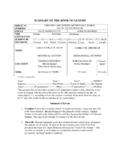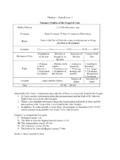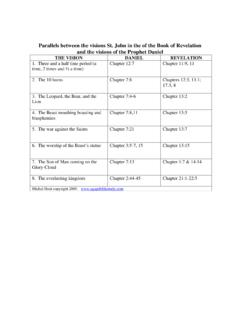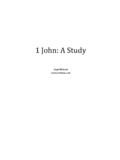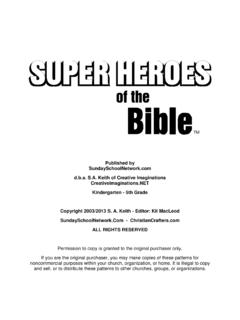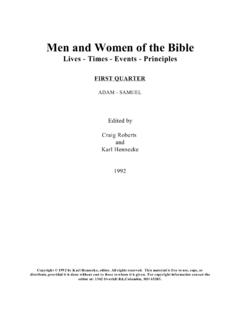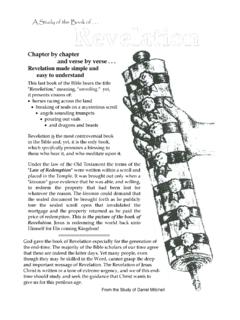Transcription of Handout 1: Luke Lesson 11 - Agape Catholic Bible Study
1 Handout 1: luke Lesson 11 In chapters 12-14 there is a repeated reference to food and meals in Jesus sayings and parables; He concludes this trend in His teaching with the Parable of the Great Feast: #1: luke 12:19 The Parable of the Rich Fool who thought happiness was in eating the stored abundance of his harvest #2: luke 12:36 The Parable of the Vigilant and Faithful Servants who are rewarded by their master who serves his servants a banquet at his table #3: luke 12:42 The food allowance the faithful steward is responsible for distributing #4: luke 12:45 The unfaithful servants who abuse the Master s table by eating and getting drunk #5: luke 13:20-21 The Parable of the Leaven in which a little bit of leaven makes an abundance of bread #6: luke 13.
2 26 The unrighteous who will claim they ate and drank in the Lord s presence #7: luke 13:29 The multitude who will come from the four corners of the earth to eat at the table in the Kingdom of God #8: luke 14:7-9 A teaching on conduct at a banquet #9: luke 14:12-14 Those who invite the poor to a banquet will be blessed #10: luke 14:15-24 The Parable of the Great Feast Michal E. Hunt Copyright 2013 Chapter 14 records the third banquet with the Pharisees and scribes and the fifth Sabbath healing. Banquets Jesus attended at the homes of Pharisees: 1. When Jesus pardoned the sinful woman (Lk 7:36-50) 2. When Jesus condemned the hypocrisy of the Pharisees and scribes (Lk 11:37-53) 3. When Jesus was invited to a Sabbath meal at the home of a leading Pharisee (Lk 14:1-6) Healings on the Sabbath: 1.
3 Healing a demon possessed man at the Capernaum Synagogue (Lk 4:31-35) 2. Healing Simon-Peter s mother-in-law (Lk 4:38-39) 3. Healing a man with a withered hand (Lk 6:6-10) 4. Healing the crippled woman (Lk 13:10-17) 5. Healing the man with dropsy (Lk 14:1-4) The Parable of the Wedding Banquet (Lk 14:7-14) The wedding banquet The Eucharistic banquet The host Jesus Christ The guests who seek the places of highest honor The self-righteous who will be least in the kingdom The guest who seeks the lowest seat The humble who the host will exalt Michal E. Hunt Copyright 2013 The immediate context is the Eucharist. The eschatological sense of this parable is the Wedding Supper of the Lamb at the end of time as we know it.
4 At that gathering, attended by all the saints, the places of honor will be given to the most humble servants of the Bridegroom, Jesus Christ. Michal E. Hunt Copyright 2013 Handout 2: luke Lesson 11 The Parable of the Great Feast concludes the series of teachings dealing with food or banquets. Symbolic Imagery in the Parable of the Great Feast (Lk 14:15-24) The host of the banquet God His home The heavenly Kingdom The banquet The banquet of the righteous at the end of time The servants God s prophets The first invited guests The people of the Old Covenant (Jews) The second group of invited guests The disadvantaged Jews who were the outcasts The third group of invited guests The Gentiles who have been outside the covenant but are now included Michal E.
5 Hunt Copyright 2013 In chapter 15 Jesus gives three parable teachings to the crowds concerning God s patience and mercy in calling sinners to salvation by using common examples of daily life. He gives the example of a shepherd searching for a lost sheep, a woman searching for a lost coin and a father who welcomes a lost son. Who are the father, the shepherd and the woman? They are God the Father, Christ and the Church. Christ carries you on his body, he who took your sins on himself. The Church seeks and the Father receives. The shepherd carries. The mother searches, the father clothes. First mercy comes, then intercession, and third reconciliation. Each complements the other. The Savior rescues, the Church intercedes, and the Creator reconciles (St.)
6 Ambrose, Exposition of the Gospel of luke , ) . Symbolic comparisons in the Parable of the Lost Sheep (Lk 15:1-7) The lost sheep Sinners The sheep fold The covenant community of the Church The shepherd Jesus Christ who went in search of the lost sheep of the house of Israel Michal E. Hunt Copyright 2013 Symbolic comparisons in the Parable of the Lost Coin (Lk 15:8-10) The woman Mother Church The collection of coins The community of the faithful The lost coin The lost sinner Michal E. Hunt Copyright 2013 Symbolic comparisons in the Parable of the Lost Son (Lk 15:11-32) the loving father God the Father the father s home the kingdom of the Old Covenant Church/Temple the distant country the secular world the elder son the religiously observant Jews the younger son the repentant sinner and the estranged Gentile nations of the world Michal E.
7 Hunt Copyright 2013 Michal E. Hunt Copyright 2013; like us on Facebook: Agape Catholic Bible Study Handout 3: luke Lesson 11 In the Parable of the Dishonest but Crafty Steward (16:1-8a), the interpretation of the parable looks to the figurative meaning of the whole parable and not for the individual parts. In this teaching, Jesus makes the point that the unrighteous can be prudent and crafty in knowing the best course of action to ensure their earthly security. Christians should follow their example in having the same foresight, ingenuity and wisdom in securing their eternal security. Jesus expands on this parable in a teaching that encourages the prudent use of one s wealth (Lk 16:8b-16). Notice that Jesus uses a series of parallels/contrasts in this part of His teaching: Parallels/Contrasts in luke 16:8b-16 children of this world children of light dishonest wealth eternal dwellings trustworthy in small maters trustworthy in great dishonest in small matters dishonest in great dishonest wealth true wealth mammon God Michal E.
8 Hunt Copyright 2013 The children of light are the disciples and the children of this world are those who do not belong to Christ. Mammon/wealth/riches can become a false god as opposed to the true God. To be a true disciple of Christ one cannot have a heart that is divided between mammon and God. luke 16:16b ..but from then on the kingdom of God is proclaimed, and everyone who enters does so with violence. There are several interpretations of the meaning of violence in this passage: The praiseworthy self-sacrifice and suffering of those who are willing to risk all for the sake of the Kingdom. The wicked violence of the powers of evil and their agents who seek to maintain their positions of power and to fight the advance of the Kingdom.
9 The Kingdom of heaven is being established despite all obstacles, even the violence done to the faithful. Symbolic Significance of the Parable of Lazarus and the Rich Man (Lk 16:19-31) The rich man The wealthy who abuse God s blessings when they ignore the plight of the poor Lazarus The poor and disadvantaged of the world Sheol The condition of divine judgment and purification Abraham The hereditary father of the Old Covenant people and a symbol of the blessings and wisdom of the just Michal E. Hunt Copyright 2013




